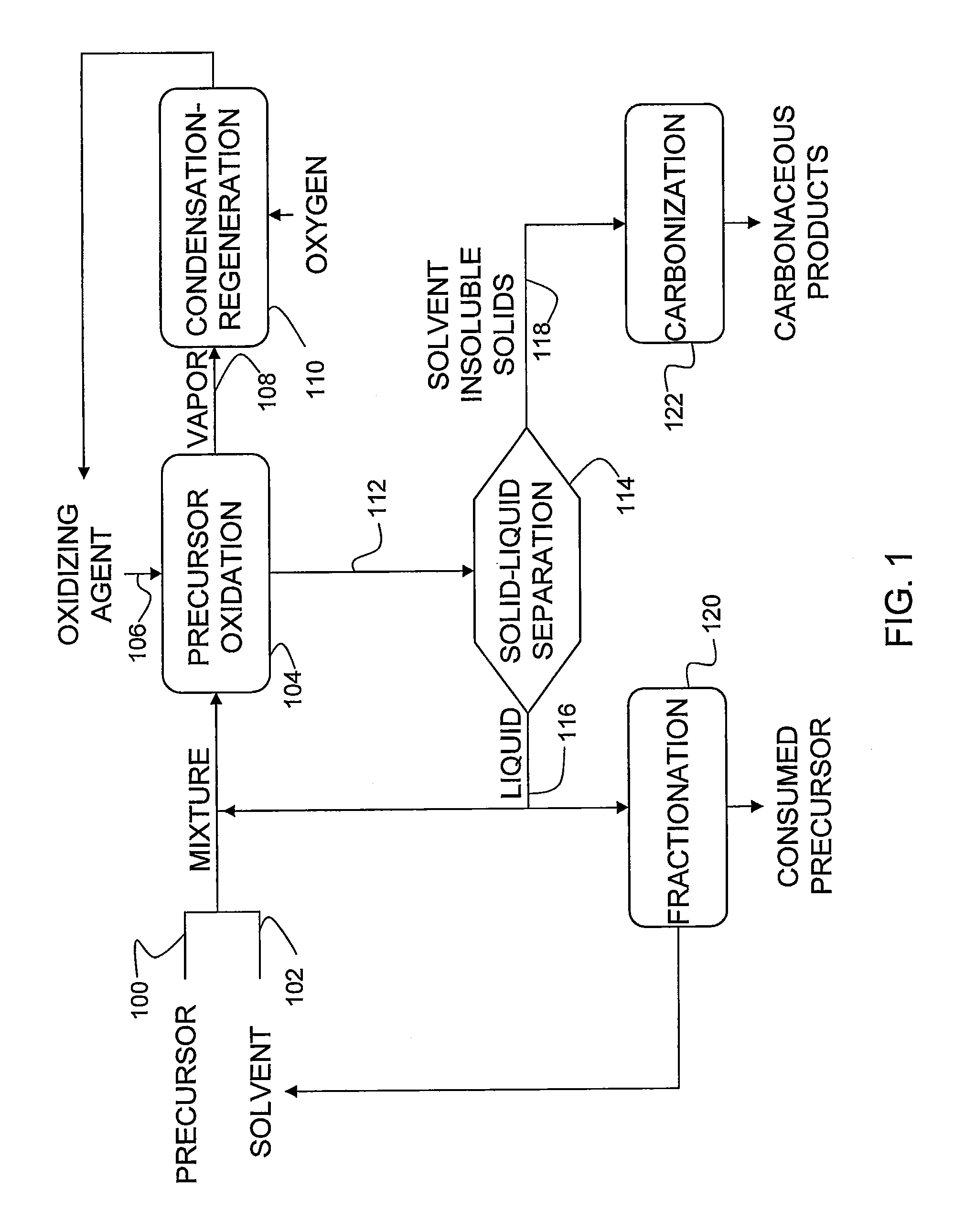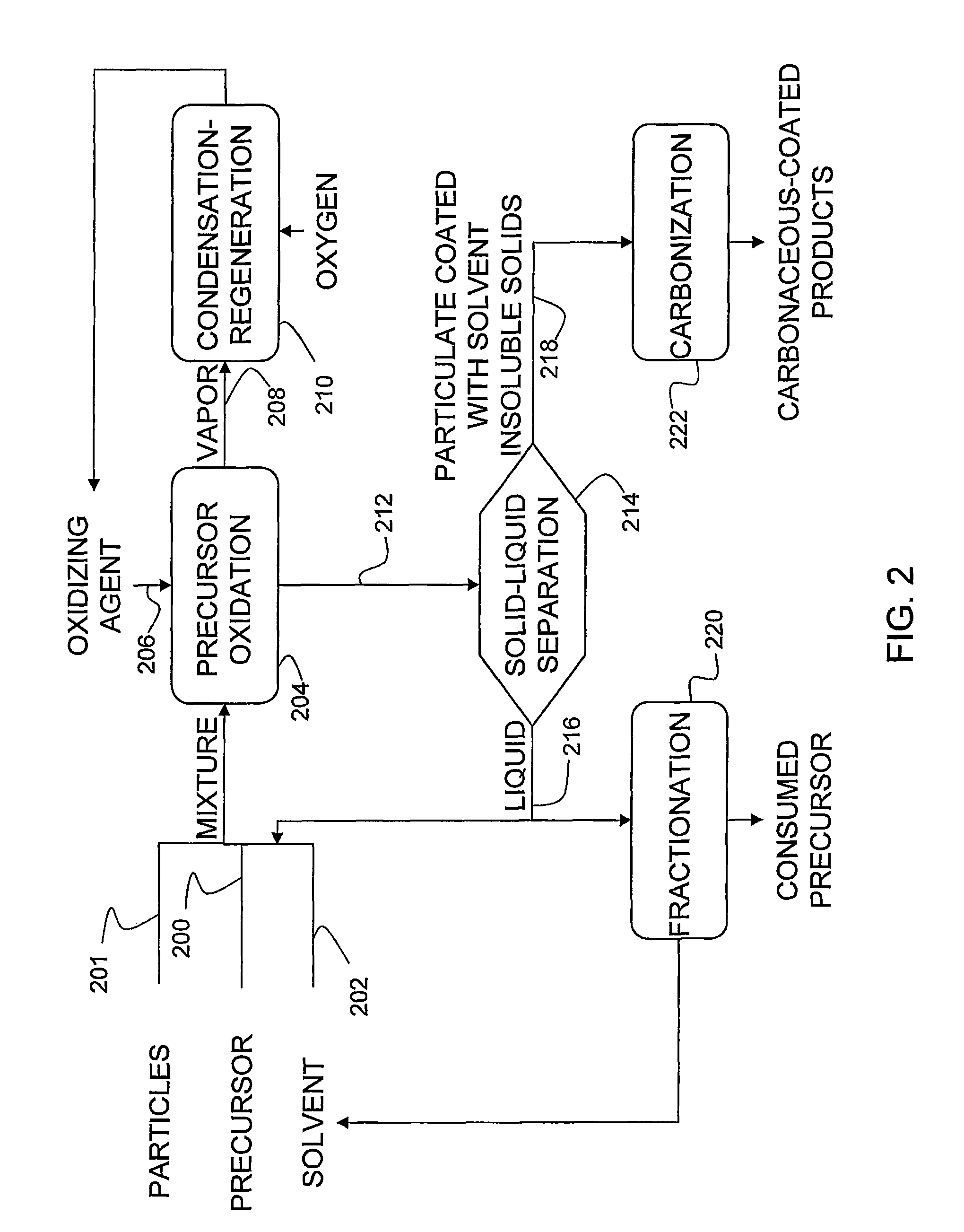Methods of preparing carbonaceous material
a carbonaceous material and carbonaceous technology, applied in the direction of cell components, conductors, electrochemical generators, etc., can solve the problems of increasing the cost of limited supply of pitches, and the price of obtaining pitches used for coating procedures, so as to increase the cost of electrode material production, and the effect of increasing the concentration of constituents
- Summary
- Abstract
- Description
- Claims
- Application Information
AI Technical Summary
Benefits of technology
Problems solved by technology
Method used
Image
Examples
example 1
[0031]A mixture was prepared with 19.6 grams of 510° C. boiling point fraction from a decant oil (ConocoPhillips refinery) and 7.3 grams of xylene and heated to about 100° C. While the mixture was continuously agitated, 4.0 grams of 69% nitric acid was added into the mixture at a rate to maintain the temperature at about 100° C. Next, the mixture was agitated and heated to about 138° C. with additional boiling xylene added making ratio of xylene to decant oil 5 to 1 prior to being cooled to about 23° C.
[0032]Xylene insoluble solid particles were then separated out of the mixture by filtration, washed twice with 200 milliliters of xylene and dried at 100° C. under vacuum for 15 hours. A resulting powder weighed 2.4 grams, or 12% of initial amount of the decant oil that did not contain any xylene insoluble content. The resulting powder did not melt under nitrogen atmosphere at any temperature.
[0033]A stabilization was conducted under reduced air pressure (−20 inch Hg) with the followi...
example 2
[0034]A mixture was prepared with 29.0 grams of 510° C. boiling point fraction from a decant oil (ConocoPhillips refinery), 22.7 grams of green coke particles with an average particle size of 8 μm and 138.0 grams of xylene and heated to about 65° C. While the mixture was continuously agitated, 6.93 grams of 69% nitric acid was added into the mixture at a rate to maintain the temperature below 80° C. Next, the mixture was agitated and heated to about 138° C. prior to being cooled to about 23° C.
[0035]Particulate coated with xylene insoluble solid products were then separated out of the mixture by filtration, washed twice with 200 milliliters of xylene and dried at 100° C. under vacuum for 15 hours. The resulting powder was examined under scanning electron microscope and found that each of the coke particles was coated with deposits from oxidation of the decant oil. Based on weight of a resulting powder, the powder had a coating level of the deposits on the coke particles of 18.2% to ...
example 3
[0036]A mixture was prepared with 19.7 grams of 510° C. boiling point fraction from a decant oil (ConocoPhillips refinery), 19.7 grams of calcined coke particles with an average particle size of 8 μm and 55.0 grams of xylene and heated to about 102° C. While the mixture was continuously agitated, 4.0 grams of 69% nitric acid was added into the mixture at a rate to maintain the temperature below 105° C. Next, the mixture was agitated and heated to about 138° C. with additional boiling xylene added making ratio of xylene to decant oil 5 to 1 prior to being cooled to about 23° C.
[0037]Particulate coated with xylene insoluble solid products were then separated out of the mixture by filtration, washed twice with 200 milliliters of xylene and dried at 100° C. under vacuum for 15 hours. The resulting powder was examined under scanning electron microscope and found that each of the coke particles was coated with deposits from oxidation of the decant oil. Based on weight of a resulting powde...
PUM
| Property | Measurement | Unit |
|---|---|---|
| boiling point | aaaaa | aaaaa |
| mass ratio | aaaaa | aaaaa |
| mass ratio | aaaaa | aaaaa |
Abstract
Description
Claims
Application Information
 Login to View More
Login to View More - R&D
- Intellectual Property
- Life Sciences
- Materials
- Tech Scout
- Unparalleled Data Quality
- Higher Quality Content
- 60% Fewer Hallucinations
Browse by: Latest US Patents, China's latest patents, Technical Efficacy Thesaurus, Application Domain, Technology Topic, Popular Technical Reports.
© 2025 PatSnap. All rights reserved.Legal|Privacy policy|Modern Slavery Act Transparency Statement|Sitemap|About US| Contact US: help@patsnap.com


